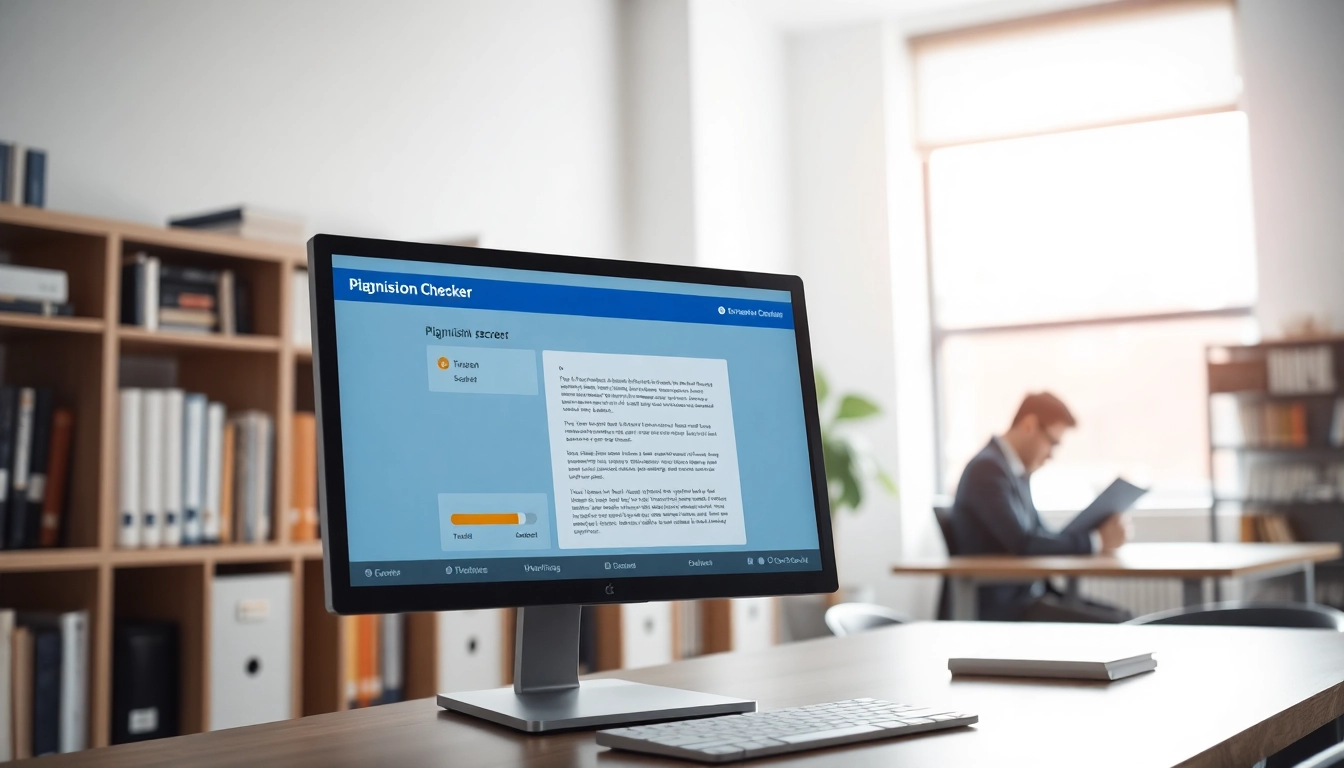Understanding the Importance of a Plagiarism Checker
In an era where information is readily available and easily shared, maintaining the integrity of written content has never been more crucial. It seamlessly integrates into both academic and professional settings, where the originality of material is paramount. A reliable plagiarism checker serves as a vital resource in ensuring that your work is free from unintentional plagiarism. In this comprehensive guide, we will explore the significance of plagiarism checkers, how they function, selecting the most suitable tool, and much more.
What is Plagiarism and Why Avoid It?
Plagiarism is defined as the act of using someone else’s work, ideas, or intellectual property without proper acknowledgment, presenting it as one’s own. It is a serious offense that can lead to academic penalties, damage to professional reputation, and legal repercussions. Understanding the nature of plagiarism is the first step toward avoiding it. Plagiarism can take various forms, including:
- Direct Plagiarism: Copying someone else’s work word-for-word without citation.
- Self-Plagiarism: Reusing one’s previous work without acknowledgment.
- Mosaic Plagiarism: Mixing copied phrases with one’s own without proper citation.
- Accidental Plagiarism: Failing to cite sources correctly, often due to negligence.
Avoiding plagiarism is essential for ethical writing practices and promotes academic integrity. By employing effective citation methods and utilizing a plagiarism checker, writers can safeguard their work against unintentional misrepresentation of sources.
The Role of a Plagiarism Checker in Academic Integrity
A plagiarism checker plays a crucial role in upholding academic integrity by identifying instances of copied material before they can lead to serious consequences. It serves as a safeguard for students, educators, and professionals by:
- Enhancing Originality: Ensuring that the content is original and adds unique value to the existing body of knowledge.
- Promoting Ethical Writing: Encouraging writers to acknowledge their sources and avoiding unethical practices.
- Saving Time: Quickly analyzing large volumes of text for similarities, reducing the manual effort required to check for plagiarism.
- Providing Peace of Mind: Allowing writers to submit their work with confidence, knowing they are adhering to academic standards.
Common Myths about Plagiarism Checkers
Despite the clear benefits of using plagiarism detection tools, several misconceptions persist regarding their effectiveness and purpose:
- Myth 1: All Plagiarism Checkers are the Same: There is a significant variation in the accuracy, features, and databases used by different plagiarism checkers.
- Myth 2: Plagiarism Checkers Guarantee Zero Plagiarism: While they significantly reduce the chances of plagiarism, they cannot guarantee absolute originality. Human judgment and thoroughness in citations are still essential.
- Myth 3: They Only Check for Textual Matches: Many advanced plagiarism checkers analyze writing structure and style, not just word-for-word matches, helping identify potential plagiarism beyond simple copying.
- Myth 4: Plagiarism Checkers Are Only for Students: Everyone engaged in writing—professors, researchers, content creators—can benefit from using these tools.
How Plagiarism Checkers Work
The Technology Behind Plagiarism Checkers
Plagiarism checkers leverage sophisticated algorithms and extensive databases to detect similarities between submitted content and existing material. Here’s how they typically work:
- Text Input: Users submit the text they wish to check.
- Database Comparison: The tool scans its database, which may include academic papers, website content, and previous submissions, searching for matching phrases and sentences.
- Similarity Analysis: Utilizing algorithms, the tool assesses the degree of similarity and highlights portions that match other sources.
- Report Generation: A comprehensive report is created, indicating matching text, the sources of the matches, and a similarity index that represents the percentage of original content.
Types of Content Detected by Plagiarism Checkers
Plagiarism checkers can identify a wide range of content types. Among them are:
- Academic Papers: Essays, dissertations, theses, and research articles.
- Web Content: Articles, blog posts, and website copy.
- Technical Writing: Manuals, reports, and instructional documents.
- Creative Works: Stories, poems, and other artistic compositions.
This diverse capability allows plagiarism checkers to cater to different writing genres and industries effectively.
Evaluating the Accuracy of a Plagiarism Checker
When selecting a plagiarism checker, accuracy is one of the most important factors to consider. Evaluating a tool’s effectiveness can involve:
- Reference Database: Check what sources the tool searches against. A larger database generally results in better accuracy.
- Algorithms Used: Advanced algorithms that incorporate natural language processing can identify complex forms of plagiarism.
- User Reviews: Read testimonials and reviews from previous users to gauge the reliability and accuracy of the plagiarism checker.
- Sample Tests: Some tools offer free trials. Utilizing these features can provide a practical sense of the checker’s performance.
Choosing the Right Plagiarism Checker for Your Needs
Free vs. Paid Plagiarism Checkers: What to Consider
One of the initial decisions when selecting a plagiarism checker is whether to use a free or paid version. Here are considerations for each:
- Free Checkers: Often offer basic functionality and limited database access. They can be a good starting point for casual users or those on a budget.
- Paid Checkers: Typically offer more features, including deeper database access, advanced reporting tools, and better accuracy. Ideal for professionals and students who need thorough checks.
Ultimately, the choice should reflect individual needs and frequency of use. Regularly writing professionals may benefit more from a paid subscription.
Key Features to Look For in a Plagiarism Checker
The following features are crucial when selecting a plagiarism checker:
- Comprehensive Database: Access to a diverse array of sources enhances detection accuracy.
- Multiple Formats Supported: Choose a checker that can analyze different file types (e.g., Word documents, PDFs, etc.).
- User-Friendly Interface: An intuitive layout makes the tool easier to navigate.
- Detailed Reporting: Look for tools that provide detailed reports outlining matches, sources, and plagiarism percentages.
- Integration Options: Some checkers integrate seamlessly with writing tools and platforms, improving workflow.
User Reviews and Recommendations for Plagiarism Checkers
Before committing to a plagiarism checker, investigating user reviews can provide insights into experiences and satisfaction levels. Look for:
- Rating Scores: Higher scores indicate better user experiences.
- Feature Highlights: Positive reviews often highlight what users appreciate most about the tool.
- Customer Support: Responsive and helpful customer service can be a deciding factor for many users.
Implementing a Plagiarism Checker in Your Workflow
Best Practices for Using a Plagiarism Checker
Effectively integrating a plagiarism checker into your writing workflow can maximize its benefits. Here are some best practices:
- Check Early: Run a plagiarism check during initial drafts to catch issues before finalizing content.
- Use It as a Learning Tool: Learn from the reports generated. Understanding why your text flagged can help improve your writing.
- Customize Settings: If the tool allows, adjust settings for sensitivity levels to suit your specific needs.
How to Integrate Plagiarism Checkers into Academic Writing
For students and academics, integrating a plagiarism checker is essential for maintaining academic integrity:
- Submit Drafts: Regularly check drafts while researching, before submitting final papers.
- Collaboration: Share access to plagiarism tools with peers to verify each other’s work collaboratively.
- Consult Guidelines: Familiarize yourself with the citation style and requirements relevant to your academic discipline to avoid potential pitfalls.
Assessing Plagiarism Checker Reports
Understanding the reports generated by plagiarism checkers is vital. Here’s how to decode them effectively:
- Match Highlights: Identify which parts of your text were flagged and compare them with the original source.
- Sources Listed: Review the sources that matched portions of your text to ensure proper citation.
- Similarity Index: Use the provided percentage as a guideline, but examine the context of flagged content to discern its relevance.
The Future of Plagiarism Detection Tools
Innovations in AI for Plagiarism Detection
The future of plagiarism detection holds exciting possibilities, with advancements in artificial intelligence (AI) driving innovation:
- Improved Contextual Analysis: AI will enable tools to understand context better, helping to differentiate between acceptable and unacceptable similarities.
- Real-Time Detection: Future plagiarism checkers may integrate with writing tools to provide real-time feedback as you write.
- Learning Algorithms: AI can learn from user data to adapt services to better meet individual needs over time.
Trends to Watch in Plagiarism Checking Technology
There are several trends likely to shape the landscape of plagiarism detection:
- Increased Use of Blockchain: Utilizing blockchain technology can create a permanent, immutable record of intellectual property.
- Integration with Educational Platforms: Tools may become embedded in learning management systems, making them easier to access.
- Expansion of Multi-Language Support: Future checkers may offer enhanced support for non-English texts to cater to a global audience.
Building a Culture of Originality with Plagiarism Checkers
Ultimately, fostering a culture of originality through the use of plagiarism detection tools is vital for academic and professional success:
- Educational Initiatives: Institutions should promote workshops on understanding plagiarism and using checkers effectively.
- Encouraging Ethical Research: Recognizing the value of original thought and research can inspire a higher standard of work.
- Leadership by Example: Faculty and industry leaders should model transparency and ethical writing practices, using plagiarism checkers as a norm in their own work.
In conclusion, leveraging a reliable plagiarism checker is integral to ensuring the originality of your written material and enhancing your credibility. By understanding how these tools work and their critical role in maintaining academic integrity, you can take proactive steps toward enhancing the quality and originality of your writing.



